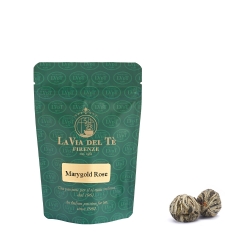
Blooming Teas
The Chinese art of blooming teas (Gong Yi HuaCha), is unique: only the young buds, or the young spring buds and the tender leaves under, are hand-tied together through a cotton or silk thread with edible flowers, in the shape of balls, towers and bunches.
Also known as Flowering Teas or Art Teas, their origin may trace to 10th-century Yunnan Province, where early spring teas were picked, processed, and tied into various shapes for the amusement of the emperor.
In Fujian, one of the producing countries of blooming teas, the same raw material of Silvery Needles are used.
These true tea masterpieces found a new audience in the West about a decade ago, and several luxury venues use these colourful teas during the service of refined afternoon tea.
Better to infuse the blooming teas in a glass teapot to enjoy their slowly opening.
As the leaves rehydrate and bloom, the hidden blossom slowly floats free from its tea-leaf nest and fills the container with colour and aroma.
Display teas generally do not become bitter when overstepped.
They develop a delicate and soft fragrance and the infusion has a round, sweet, floral taste. You can brew them up to 3 times.









